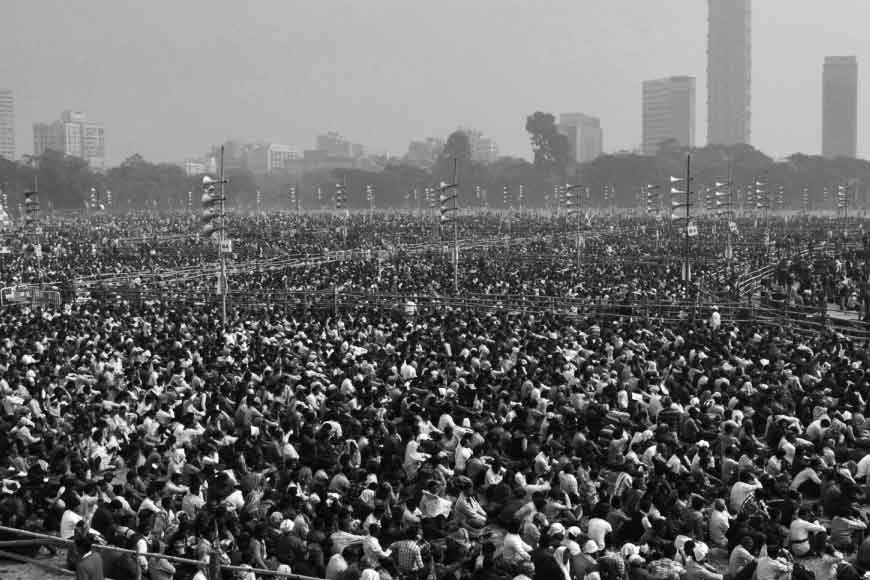The Brigade wave

Today, February 28, the Left-Congress alliance are holding a rally at Brigade Parade Ground. Election drums in the state had sounded long ago, so the rally is hardly a surprise. If Prime Minister Narendra Modi does make it to Kolkata again, the BJP are scheduled to hold a rally there too. Trinamool Congress are yet to announce their Brigade rally, since the Chief Minister seems more interested in doing the rounds of the district headquarters for now. However, for nearly half a century, Bengal’s political parties have grown ever more certain that no election campaign is complete without at least one Brigade rally.
Sheikh Mujibur Rahman, too, was felicitated at Brigade following Bangladesh’s 1971 War of Liberation, and both he and Indira Gandhi, riding on their individual crests of popularity, spoke on the occasion. Pope John Paul II was honoured here on his tour of Kolkata, with a cultural extravaganza.
In the British era, the parade ground, as is evident from the name, was used for Army drills. Post-Independence, as some elder citizens might recall, among the largest public gatherings at the venue was the one where Soviet premiers Nikolai Bulganin and Nikita Krushchev were felicitated. This was 1955, and since VIP Road (Nazrul Islam Sarani) was yet to be built, VIPs had to drive along Jessore Road from the airport to come to Kolkata. Among them were the two Soviet leaders, Chou En Lai and Queen Elizabeth. The day after the felicitation of the Soviet premiers on November 30, Anandabazar Patrika reported, “If one were to draw a quadrilateral line from the wide courtyards of Victoria Memorial to Dalhousie Square, from Chowirnghee to the hillocks of Fort William, and the gathering to be fitted into it, how many people would it hold? How many lakhs? One is constantly afraid of quoting a number, because however large it is, it is likely to be inadequate. For this was not simply a gathering, this imaginary quadrilateral was the Pacific Ocean to which innumerable streams rushed.”
Not just electoral or victory rallies either. Rallies at Brigade have been staged for various reasons, under various circumstances. Among the speakers have been Indira Gandhi, Jyoti Basu, Jayprakash Narayan, Rajiv Gandhi, Atal Behari Vajpayee, P.V. Narasimha Rao, Mamata Bandyopadhyay, and numerous others.
Sheikh Mujibur Rahman, too, was felicitated at Brigade following Bangladesh’s 1971 War of Liberation, and both he and Indira Gandhi, riding on their individual crests of popularity, spoke on the occasion. Pope John Paul II was honoured here on his tour of Kolkata, with a cultural extravaganza. Brigade was also the venue for the memorial service of CPIM leader Pramod Dasgupta, where Prafulla Sen and Priya Ranjan Dasmunshi were among the speakers. Without a doubt, Jyoti Basu remains the leader who has held the largest number of rallies at Brigade, though ironically, his memorial service was held at Shahid Minar. One other foreign dignitary who missed out was Nelson Mandela, whose felicitation was held at Eden Gardens.
For nearly half a century, Bengal’s political parties have grown ever more certain that no election campaign is complete without at least one Brigade rally.
For a long time, however, Brigade Parade Ground was not considered for political gatherings. In pre-1947 Kolkata, the primary venues for such gatherings were Hrishikesh Park, Shraddhananda Park, Mohammad Ali Park, or Subodh Mullick Square. To these were later added Deshbandhu Park, Deshapriya Park, Park Circus, and of course, Ochterlony Monument (later renamed Shahid Minar).
In 1967, like many other states of the country, West Bengal too saw the formation of a non-Congress United Front government. Very soon, internal wranglings began to hamper the functioning of the government, to protest against which the CPIM called for a solo rally at Brigade. That was the rally that opened the floodgates. In 1969, the United Front scored a huge electoral victory. And two huge Brigade rallies followed in quick succession - the first by the United Front and the second, once again, by CPIM. In other words, Brigade Parade Ground turned into a platform to hold individual shows of strength.
In the British era, the parade ground, as is evident from the name, was used for Army drills. Post-Independence, as some elder citizens might recall, among the largest public gatherings at the venue was the one where Soviet premiers Nikolai Bulganin and Nikita Krushchev were felicitated. This was 1955, and since VIP Road (Nazrul Islam Sarani) was yet to be built, VIPs had to drive along Jessore Road from the airport to come to Kolkata. Among them were the two Soviet leaders, Chou En Lai and Queen Elizabeth.
Not just electoral or victory rallies either. Rallies at Brigade have been staged for various reasons, under various circumstances. Among the speakers have been Indira Gandhi, Jyoti Basu, Jayprakash Narayan, Rajiv Gandhi, Atal Behari Vajpayee, P.V. Narasimha Rao, Mamata Bandyopadhyay, and numerous others. In fact, until recently, the popularity of any political party in the state was measured by the size of the crowd it could draw at a Brigade rally.
Of late, better political sense has prevailed, because Brigade rallies are now held mostly on Sundays. This was certainly not always the case. However, given the law of diminishing returns, the size of a rally at Brigade is no longer a reliable indicator of electoral fortunes. The most prominent recent example would be 2011 when, despite an overflowing house at Brigade, the Left Front suffered a spectacular electoral defeat. In the days to come, no doubt the Brigade Parade Ground will witness many more important gatherings. But it is likely that none of them will become barometers to measure the outcomes of an electoral battle. No matter who gives the call, how many of the state’s 10 crore people actually turn up at Brigade?











